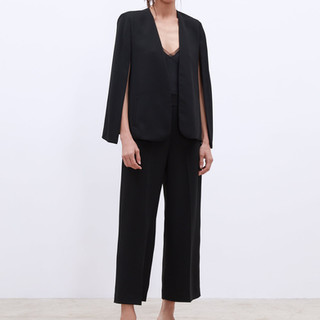Work Wear Dress Codes: What is appropriate?
- Eloise Stewart
- Aug 20, 2019
- 4 min read
Updated: Feb 2, 2020
Work Wear Dress Codes: What is appropriate?



Have you ever been told the dress code for a job, interview, networking event, conference, or presentation and not known what it REALLY meant in terms of actual clothing?
We have been there too!
We thought we would break down the 3 most popular professional dress codes with examples and brand suggestions. Obviously, this is not a comprehensive list and there will always be exceptions or changes as our work environments turn to more remote working and casual workplaces.
WHEN IN DOUBT: If you are still unsure what to wear to an interview or first day of work, ask your contact at the company (the person who emailed you to set up the email or the person who hired you). There is NO shame is asking. It would actually show your initiative, effort, and professionalism to clarify the expectations.
REMEMBER THIS!
No matter how casual or relaxed your environment, employer or co-workers are,
present yourself at the level you want your work to be respected.
Put forth effort in the small or be considered for the big.
Follow the dress code, but uphold a higher standard for yourself.
BUSINESS PROFESSIONAL

What is it?
When you think of Business Professional, think conservative and traditional.
This means your clothing covers more with longer length skirts, dresses, sleeves, and higher necklines. This does NOT mean you have to be boring. And this does NOT mean you can’t look attractive with flattering clothing. It means the opposite (in my opinion). It means your clothing is well-fitted to your curves and pressed. Think clean and simple lines across your whole body.
When is it appropriate?
Interviews
Traditional workplaces and industries (Examples: Law, Hospitality, Financial, Management)
Presentations
Established Conferences for traditional industries
Headshots for traditional companies
Networking
Galley of some of our favorite items:
Kohl's Apt. 9 Torie Blazer | Nine West Mahala Pointy Toe Pumps | Black Kelly and Katie Rosewell Pump | Marc Fisher Caitlin Pump | A New Day Tortoise Disk Post Earrings | J Crew Mayfair Blazer | Zara Cape Suit with Slit Sleeves | Banana Republic Long and Lean-Fit Washable Wool-Blend Blazer | Banana Republic Soft Satin Smocked Blouse
BUSINESS CASUAL / DRESSY CASUAL

What is it?
Business casual is becoming more common as working environments become more relaxed and remote. The key is balance within the outfit. If the top is more casual or colorful, the bottoms and layers are neutral. If the pants are wide and trendy, the top is professional and structured.
Though the dress is more casual and comfortable, the presentation is not. You should still have well-fitting, clean, and pressed clothing. Anyone can do this even on a tight budget.
When is it appropriate?
Interviews for casual industries
Younger or casual workplaces/industries (Examples: tech companies, food service companies, design and marketing firms)
Headshots if you are in a casual industry
Video Conference calls
Conferences
Networking
Gallery of some of our favorite items:
Loft Ponte Flippy Skirt | LC Lauren Conrad Relaxed Open-Front Blazer | Banana Republic Classic-Fit Varsity Blazer | Marc Fisher Caitlin Pump | Chocolat Blu Walter Shoe in Camel | J Crew Shawl Collar Cropped Blazer | A New Day Metal Drop Earring | H&M V-neck Blouse | Dot Buttoned Petal Sleeve Top
Business Professional VS Business Casual
A Quick Reference Guide

Pin this image to your Pinterest for quick reference!
CASUAL FRIDAY

What is it?
You may have 1 day a week for “Casual Friday” type dress. Or you may have 4 out of 5 days.
Many of the items that are listed in the Business Casual list are appropriate for Casual Friday.
Here are a couple of differences:
Open toe shoes or sneakers are common.
Denim is common as long as it is in good condition
Express yourself with accessories if your clothing is simple.
Sometimes shorts or skorts are appropriate depending on the work you are doing.
Avoid spaghetti straps and strapless.
Ask before wearing hats
The 3 most important things to remember are:
Even if your workplace is a casual Friday place every day, you still need to dress in Business Casual or Business Professional when you are interviewing, presenting in front of clients, or meeting new clients.
Even if you are wearing a knit t-shirt and jeans, those items need to fit well with no wrinkles, stains, or worn/faded spots. Don’t wear old jeans that sag in the rear and look 5 years old (save those for Saturday).
Watch out for distressed jeans and pants. Ask your boss or co-worker if it is appropriate.
When is it appropriate?
For days specified by your employer or boss (not you)
For days that you are not presenting, attending conferences, interviewing, or meeting new clients
For days that you have more physical work to do
Be careful how casual you are for video conference calls - just because you are not there, doesn’t mean you shouldn’t be dressed
Galley of some of our favorite items:
Loft Denim Skirt | A New Day Short Sleeve V-Neck | Wood Wedge Disc Earrings | Lou & Grey Chambray Wrap Shirt | Spanx Distressed Skinny Jeans | Dr. Scholls Dawned Wedge Slip On | Keds Crashback Leather Fashion Sneaker
Looking for more resources and information on dress codes?
Go to these great articles by BalanceCareers.com:






















































